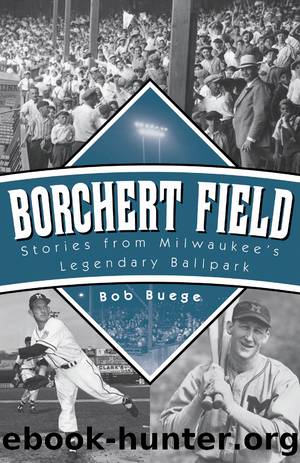Borchert Field by Bob Buege

Author:Bob Buege
Language: eng
Format: epub
Publisher: Wisconsin Historical Society Press
Published: 2017-03-15T00:00:00+00:00
Dainty Dinty Gearin made all of his teammates, like Bob Trentman here, look like giants. RICHARD LULLOFF COLLECTION
Nine seasons before Crip Polli hurled his no-hitter in St. Paul, another popular Milwaukee moundsman tossed a hitless performance at the Columbus Senators. The pitcher was Dennis John Gearin, commonly known as Denny or Dainty Dinty or, because he stood five-foot-four and weighed scarcely 145 pounds, Kewpie. He, like Cutting, was referred to as a midget and a mighty mite and a squatty southpaw and a hatful of other condescending monikers. But the man could pitch, and the locals loved him.
Gearin had thrown balls and strikes a little in 1923 and 1924 for John McGraw and the New York Giants, who paid Otto Borchert $25,000 for his services. Besides being a reliable pitcher, Dinty also excelled as an outfielder and pinch hitter. In 1920 he appeared in the Brewersâ outfield in 88 games, batting .276. In both 1921 and 1922, in fewer opportunities at the plate, he batted above .300.
Brewers manager Jack Egan sometimes used Gearinâs versatility in an unusual fashion. If Dinty was pitching and a feared right-handed hitter came to bat, Egan would shift Gearin to right field, bring in a right-handed hurler to face that one batter, then bring Dinty back to the mound. The first time that owner Otto Borchert saw Egan make this exchange, he was livid, reportedly yelling down from his perch atop the grandstand, telling Egan not to make a mockery of the game. When the switch worked successfully, Borchert became an instant convert to the strategy.
Gearin became just the second Milwaukee Brewers hurler to throw a no-hitter in Athletic Park. Czechoslovakia native Joe Hovlik had accomplished the feat on August 20, 1912, in the first game of a doubleheader with Louisville. Fourteen years and one day later, Gearin âstalked into the heaven of baseballâs immortals,â as Manning Vaughan described it in the Milwaukee Journal. Two men were issued walks and one batter was safe on an error, but no Columbus runner reached third base in a 10â0 shellacking. In an odd display of what used to be considered sportsmanship, the final two Columbus batters of the game each signaled surrender by taking a called third strike.
It took a 25-year wait after Gearinâs dazzler, but the Milwaukee Brewers pitching staff produced one more home no-hitter. This one was an abbreviated seven-inning affair, the customary short leg of a doubleheader in Borchert Field against the Toledo Mud Hens on August 16, 1951. Charlie Grimmâs pennant-bound Brewers trounced the visiting Hens, 5â0, in the opener with the help of a double and a home run by big George Crowe. Right-hander Bert Thiel, who had pitched a similar seven-inning no-hitter for the Hartford Chiefs in the Eastern League a year earlier, was in total command throughout the contest. He allowed two base runners, one on a walk in the second inning and one in the sixth when massive shortstop Buzz Clarkson dropped an easy pop-up. Despite the muff, Thiel remained unflappable.
Download
This site does not store any files on its server. We only index and link to content provided by other sites. Please contact the content providers to delete copyright contents if any and email us, we'll remove relevant links or contents immediately.
Kathy Andrews Collection by Kathy Andrews(10519)
The remains of the day by Kazuo Ishiguro(7551)
Spare by Prince Harry The Duke of Sussex(4195)
Paper Towns by Green John(4169)
The Body: A Guide for Occupants by Bill Bryson(3800)
Be in a Treehouse by Pete Nelson(3212)
Harry Potter and the Goblet Of Fire by J.K. Rowling(3045)
Goodbye Paradise(2962)
Never by Ken Follett(2880)
Into Thin Air by Jon Krakauer(2701)
The Remains of the Day by Kazuo Ishiguro(2618)
The Genius of Japanese Carpentry by Azby Brown(2609)
The Cellar by Natasha Preston(2595)
Drawing Shortcuts: Developing Quick Drawing Skills Using Today's Technology by Leggitt Jim(2532)
120 Days of Sodom by Marquis de Sade(2437)
Architecture 101 by Nicole Bridge(2350)
The Man Who Died Twice by Richard Osman(2298)
Machine Learning at Scale with H2O by Gregory Keys | David Whiting(2290)
Fairy Tale by Stephen King(2069)
